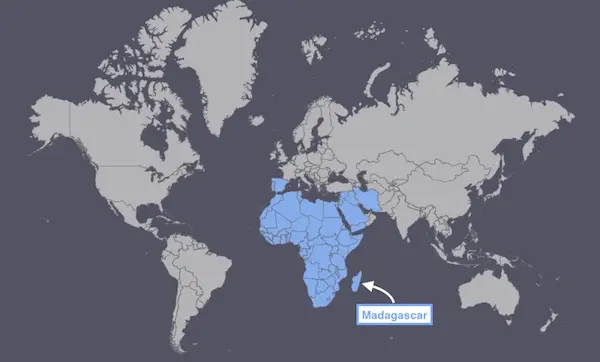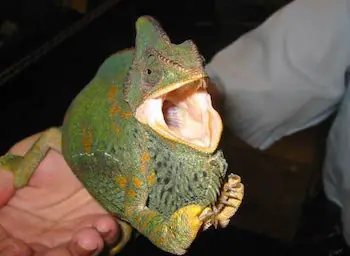Learn where chameleons are found throughout the world
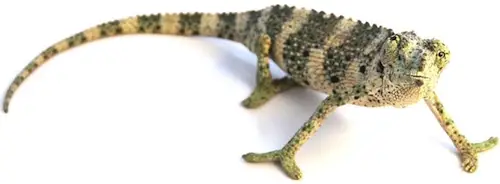
Where do Chameleons live?
Chameleons are primarily found on the continent of Africa, with high concentrations in Madagascar. However, there are smaller numbers of chameleons living in Europe, the Middle East, and even Southern India. Interestingly, there are even populations established elsewhere, outside their native range. Chameleons often prefer mild climates with high humidity, but again there are always exceptions, which we’ll detail below. So, if you’re ready to learn where your pet chameleon originated from, let’s dive into the information!
Here’s a custom design I put together showing a range map of where
chameleons are found throughout the world. You can now see a
visual of just how concentrated their populations are in Africa.
Chameleons on the continent of Africa
There are around 160 species of chameleon that have been identified by science, and the vast majority of them are indigenous to the continent of Africa. While that may not seem overly impressive considering how much land Africa covers, keep in mind that around half of the world’s 160 chameleon species are found only on the island of Madagascar, which is located off the coast of Tanzania.
I’d even take this a step further and say that Madagascar is not only home to the most chameleon species, but it’s also home to the most impressive species. It truly is a chameleon-lovers dream, and someday I’d really like to visit the island. I’ve drawn an arrow to it on the above chameleon range map.
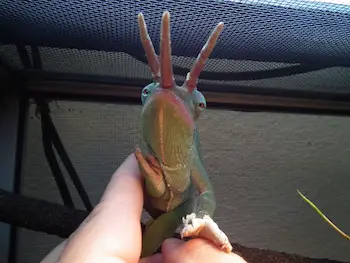
Here’s one of my male Usumbura Three-horned chameleons
(Trioceros deremensis) with exceptionally long horns. This
species hails from the Usambara mountain range
in the African country of Tanzania.
Africa has every climate imaginable, and chameleons live in most of them. Below I’ll detail where chameleons fit into the different habitats, including species-specific regions.
Northern Africa - The northern portion of the continent is mostly arid deserts (think Sahara), where there are actually several species of chameleon that thrive in the dryness. This is unusual for chameleons as a whole because they’re most commonly known for wanting to avoid extreme heat and preferring very high humidity. Nevertheless, some species adapt and thrive.
One desert chameleon worth mentioning is the Namaqua chameleon. It doesn’t hail from Northern Africa, but actually the Namib desert in Southern Africa. It’s almost entirely terrestrial (another curveball, considering nearly all chameleons species are arboreal), has a very short non-prehensile tail (another oddity), and buries itself in the desert sand to help thermoregulate its body temperature when needed.
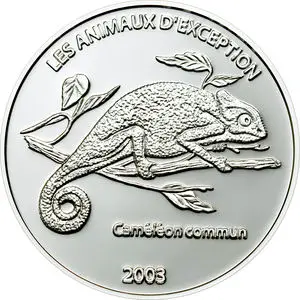
Here’s a 10 franc coin from the country of Congo,
depicting a common resident chameleon.
Central Africa - This expansive range of land is home to many species of chameleon including some of the more commonly seen species such as Senegal (Chamaeleo senegalensis), Graceful (Chamaeleo gracilis) and Flapneck (Chamaeleo dilepis), but also to some of the rarer species such as the Strange-nosed (Kinyongia xenorhina) from the Congo and one of my favorites, the “Quad” or Four-horned (Trioceros quadricornis) from Cameroon.
Cameroon is home to many unique and special species of chameleon including the above-mentioned Four-horned (Trioceros quadricornis), the Pfeffer’s (Trioceros pfefferi), the Crested (Trioceros cristatus), and the Two-horned (Trioceros montium). I’ve been fortunate enough to hatch each of these species in captivity.
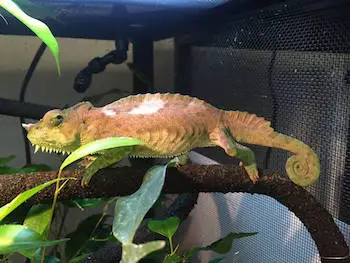
Pictured above is one of my juvenile captive bred
Four-horned chameleons (Trioceros quadricornis).
When mature, males have a very prominent set of
four to eight protruding horns.
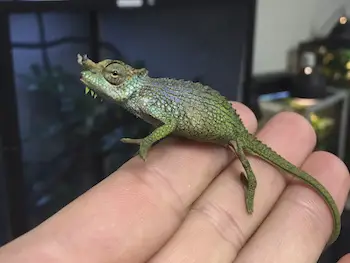
This Pfeffer’s chameleon (Trioceros pfefferi) came
in on a recent Cameroon shipment. This species
is very rarely seen in the pet chameleon hobby.
Southern Africa (Mainland) - This is a region that is home to some very unique chameleons, including the dwarf Bradypodion species, tiny Pygmy chameleons (Rhampholean sp.), the beloved Jackson’s (Chamaeleo jacksoni), and huge Meller’s chameleons (Chamaeleo melleri).
Most of these species are endemic to Tanzania, Mozambique, Kenya, and South Africa. Southern Africa is also home to Mt. Meru, and Mt. Kenya (the second tallest mountain in Africa, behind Kilimanjaro), which are both areas where some beautiful montane chameleons live. A “montane” species prefers living on or near the mountains, where temperatures are cooler. Most chameleons do not appreciate high heat, but instead prefer lower temperatures, with very few exceptions.
While Madagascar is definitely located within the Southern Africa region, the island deserves its own discussion.
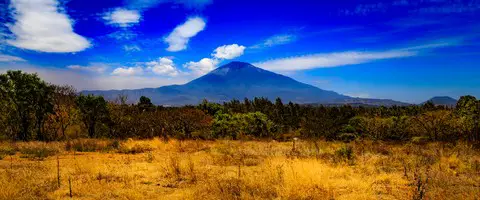
Here’s a photograph of Mt. Meru in Tanzania, where the Mt. Meru
chameleon lives. It reaches 14,968 feet, so around three miles.

Here’s a picture of Mt. Kenya in the Republic of Kenya. It’s home
to the most beautiful of the Jackson’s chameleons, the Mt. Kenya
Jackson’s (Chamaeleo j. jacksonii). It’s elevation reaches to 17,057ft.
While Madagascar is definitely located within the Southern Africa region, the island deserves its own discussion.
Madagascar - Here’s where things get incredible—think of this prehistoric island as the pinnacle of the chameleon world. The biggest chameleon, the smallest chameleon, the most colorful chameleon—they’re all live on this majestic island.
Chameleons of the Calumma, Furcifer, and Brookesia genus are indigenous to Madagascar, and really no where else other than a few scattered islands in the Indian ocean. A few notable species you’ll only find on Madagascar:
Parson’s (Calumma parsonii)
Panther (Furcifer pardalis)
Oustalet’s (Furcifer oustaleti)
Giany spiny aka Warty (Furcifer verrucosus)
Pygmy Leaf (Brookesia sp.)
O’Shaughnessy’s (Calumma oshaughnessyi)
Lesser (Furcifer minor)
Antimena (Furcifer antimena)
Elephant-ear (Calumma brevicornis)
Just to name a few. Remember, nearly half of the world’s chameleons live on Madagascar.

Middle East chameleons
There are a few chameleons living across the Middle east, most notably in Saudi Arabia and a few surrounding countries. However, one of the chameleons found there is perhaps the most prolific of them all: the Veiled chameleon (Chamaeleo calyptratus). I’ve heard that in Saudi Arabia, it’s extremely common to see a single Veiled chameleon in most trees, but rarely more than one.
European chameleons
There are just two extent species of chameleon living in Europe, but only in limited areas such as southern Spain and Portugal. The two species are the Common chameleon (Chamaeleo chamaeleon) and the African chameleon (Chamaeleo africanis).
Indian-Srl Lankan chameleon
The Indian chameleon (Chamaeleo zeylanicus) is found in select areas within India, but most notably on Sri Lanka, the large island located off the southern tip of India.
While there aren’t any native chameleons living in North America, sometimes hitchhikers on imported trees and produce can establish populations. This is what happened in Hawaii, where there are hundreds of thousands of Jackson’s chameleons breeding and thriving on every island there. There are also thousands of Veiled chameleons establishing themselves in Hawaii. Both species are officially listed by the state as invasive, albeit harmless.
South Florida has very established populations of Veiled, Oustalet’s, and others. These species will never spread north because they cannot handle the sub-freezing temperatures that occur, even as close as Orlando.
There are even Jackson’s chameleons living in Southern California, specifically Morro Bay and San Luis Obispo.
Here’s a photograph of an invasive Veiled
chameleon caught on the island of Hawaii.
Hopefully I’ve been able to thoroughly answer the question, “Where do chameleons live?” If not, or if you have suggestions for how I could improve this page’s content, please send me an e-mail. If you’re in the U.S. and you’ve found a rogue chameleon living in your area, please e-mail me a picture and the location where it was found.
